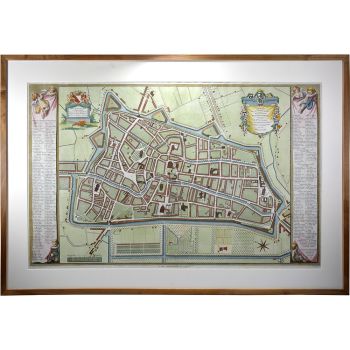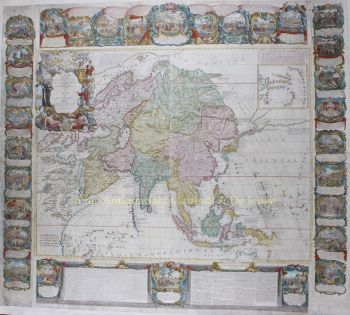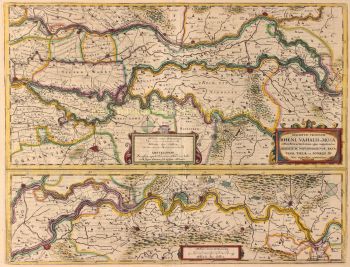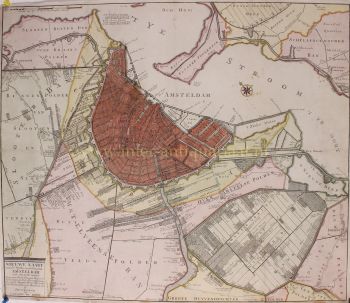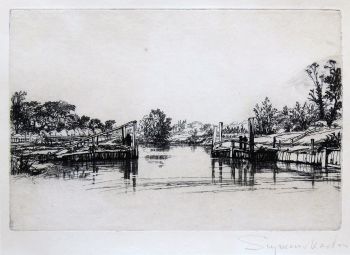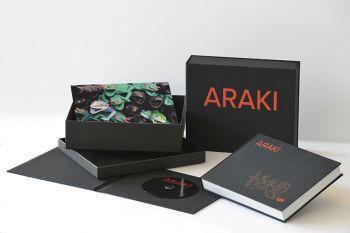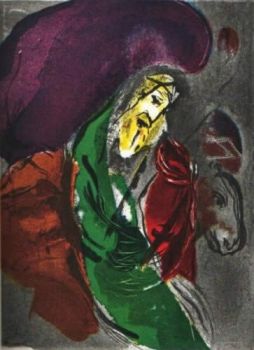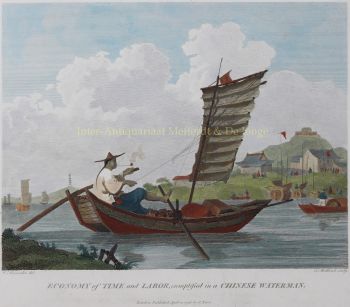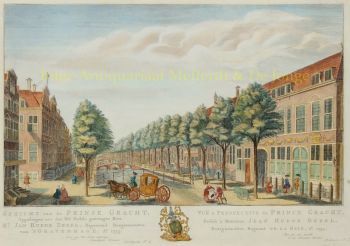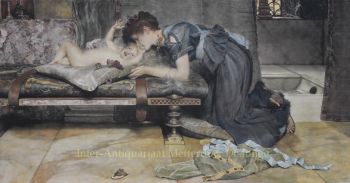Groningen 1690
Johannes Janssonius
Inter-Antiquariaat Mefferdt & De Jonge
- About the artworkSTAD GRONINGEN IN DE 17E-EEUW "Groeninga vulgo Groeningen", kopergravure van van Groningen vervaardigd in opdracht van Johannes Janssonius rond 1657, hier in een ongewijzigde uitgave van ca. 1690 door Gregorio Leti. Later met de hand gekleurd. Afm.: 41,5x51cm. Janssonius verwerft 363 koperen platen van de Keulse uitgevers Georg Braun en Franz Hogenberg en besluit daarmee in 1657 zelf een stedenboek te maken. De koperen platen werden herzien, aangepast en deels geheel nieuw vervaardigd, hij gebruikte daarbij topografische voorbeelden van Matthäus Merian, Jodocus Hondius II en van zijn Amsterdamse concurrent Joan Blaeu. Het resultaat was een indrukwekkend boek in 8 delen met daarin ruim 500 afbeeldingen van steden van de wereld. De meeste platen werden niet gesigneerd. Deze kaart van Groningen is gebaseerd op een kaart uit 1637 van Egbert Haubois, die de opdracht had gekregen de grote stadsuitleg van 1615-1624 in beeld te brengen. Gregorio Leti (1630–1701) was geschiedschrijver en satiricus, geboren in Milaan en later geëmigreerd naar Engeland. Hij schreef voor Charles II een geschiedenis van Engeland, maar vluchtte 1685 naar Amsterdam vanwege het beledigen van zijn opdrachtgever. In Holland werkte hij aan zijn “Teatro Belgico”, een boek over de geschiedenis van de Zeven Provinciën. Prijs: Euro 1.250,-
- About the artist
Janssonius was born in Arnhem as the son of Jan Jansz, a printer and publisher there. At a young age he moved to Amsterdam, the then center of the printing and card trade. In 1612 he married Elisabeth Hondius, daughter of Jodocus Hondius. Elisabeth died in 1627 and Janssonius remarried in 1629 with Elisabeth Carlier. He went to work for his father-in-law and continued the publishing business together with Henricus Hondius (son of) after his death. This was developed into one of the largest of its time. There were branches in Berlin, Frankfurt, Geneva, Lyon and Stockholm, among others.
Under Janssonius' leadership, the Mercator-Hondius Atlas was expanded and published as Atlas Novus. This initially one-volume edition soon became a multi-volume atlas, supplemented on request with nautical charts and/or celestial charts. There were publications in Dutch, French, Spanish and Latin. Like his contemporaries, Janssonius also made use of existing copper plates, including those from the city books of Braun & Hogenberg and the Description de touts les Pays Bas (Description of all the Netherlands) by Lodovico Guicciardini - (Cornelis Claesz. edition) from 1609 Although Janssonius has often been accused of copying Willem Blaeu's work, it may be noted that maps by Janssonius also appeared on the market earlier.
After Janssonius' death, the firm was continued by his son-in-law, Johannes (Jan) van Waesbergen, who was married to his daughter Elisabeth Janssonius (1615-1681). Many copper plates of the city books were used (sometimes slightly modified) by Frederik de Wit. The building on Dam Square was leased to Gerard Valck; He also bought a number of printing plates in 1694.
Are you interested in buying this artwork?
Artwork details
Related artworks
- 1 - 4 / 4
- 1 - 4 / 24
- 1 - 4 / 7
Jan Sluijters
Original illustration of Sluijters for the book: 'Laura's opstel'1881 - 1957
Price on requestKunsthandel Pygmalion
1 - 4 / 24- 1 - 4 / 12














